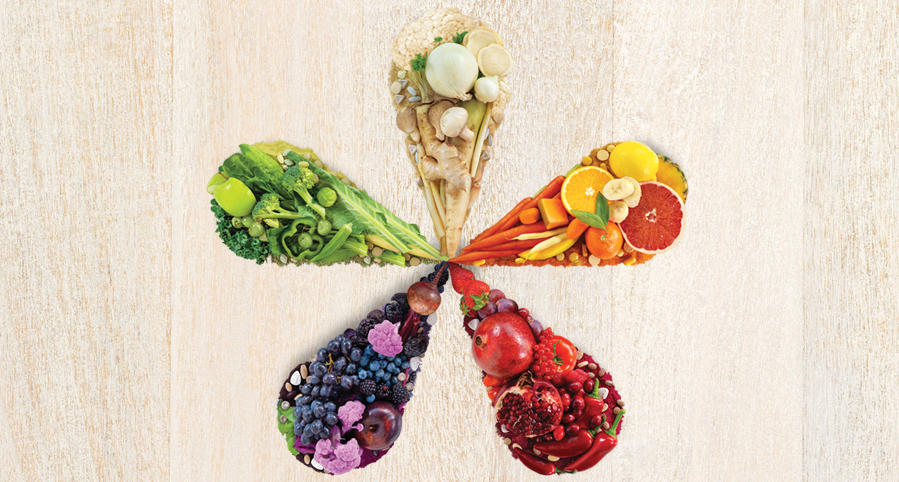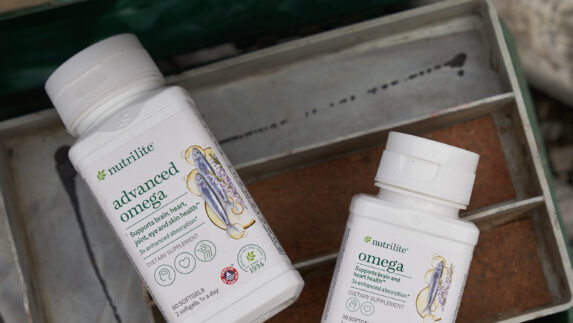It’s beautiful and quite intriguing. The Nutrilite™ Phytonutrient Spectrum, or Color Wheel as some call it, comes in a variety of looks – solid bright colors, paired with health icons, and fruits and vegetables artfully categorized. But what does it represent?
The Color Wheel helps explain different color categories of fruits and vegetables. Each of the categories has a unique fingerprint of phytonutrients, or organic compounds, that are naturally present in plants. Phytonutrients can be found in fruits, vegetables, grains, legumes, nuts and teas. Phytonutrients are widely recognized for their health benefits and contributions to healthy aging.
“Plants make phytonutrients, in part, to protect themselves from the stresses that they encounter in the environment,” said Keith Randolph, Ph.D., nutrition technology strategist at the Nutrilite Health Institute. “So within the plants’ tissues, many phytonutrients function as natural defense mechanisms. And, interestingly, our bodies have developed defense mechanisms that are strengthened by phytonutrients.
“Fruit- and vegetable-rich diets are thought to convey many of their health benefits via strengthening of defense mechanisms,” he added.
The challenge comes in trying to understand which phytonutrients provide which benefits, and how they function together with other nutritional compounds. So, how do you spot phytonutrients in fruits, vegetables and other plant foods?
“We wanted to make it easy for people to understand their food choices and how to fill gaps in their diet. Consciously incorporating color into your diet is an easy way to obtain the health benefits of fruits and vegetables, and increase the variety of phytonutrients in your diet. Using our Color Wheel as a guide to incorporate a variety of colorful fruits and vegetables into your diet helps you experience the health benefits of phytonutrients,” said Kanan Banerjee, vice president global brand management, Nutrilite.
Decades of nutrition research
Amway researchers have been evaluating the benefits of phytonutrients for decades. In fact, Nutrilite founder Carl Rehnborg created nutrition supplements based on plant concentrates and realized that fruits and vegetables contain compounds important to human nutrition. While Rehnborg didn’t have the technology needed to identify the specific compounds and their benefits, his insight pointed Nutrilite scientists in the right direction.
According to Rehnborg’s son, Dr. Sam Rehnborg, who is now president of the Nutrilite Health Institute, Carl Rehnborg wanted to figure out a way to capture the health benefits of plant materials in the form of a concentrate.
“My father is often recognized as being one of the first to understand the importance of a plant-based diet,” said Dr. Sam Rehnborg. “He thought there must be hundreds — maybe thousands — of important factors in plants and he was sure that one day, we would know how those factors benefit human health. Sure enough, today, modern technology enables us to identify these benefits and study how phytonutrients work in the body.”
So what should we eat and why?
The Color Wheel serves as a guideline to help people get enough quantity and variety of fruits and vegetables each day.
Because different fruits and vegetables contain various types and amounts of phytonutrients, choices should vary between and within each color group. As revealed in the Global Phytonutrient Report released by the Nutrilite Health Institute, consuming not just the recommended quantity of fruits and vegetables but also a variety is key to obtaining a range of health benefits. For example, in Brazil there is an abundance of tropical fruits, such as guavas, which offer lycopene to benefit heart health and bananas, which offer carotenoids benefiting bone and joint health.
The Global Phytonutrient Report includes information targeted to different regions of the world to help identify specific fruits and vegetables that will help achieve better health.
The report found that people don’t consume enough fruits and vegetables. Globally, 60-87 percent of adults fall short of meeting the World Health Organization recommended minimum of five servings (400 grams) of fruits and vegetables per day.*
Factors such as a busy lifestyle, weather conditions, cost, geography and inefficient distribution systems are likely to play roles in the availability and consumption of fruits and vegetables. In these situations, when it’s difficult or not possible to get the recommended quantity and variety of fruits and vegetables, Nutrilite™ experts recommend adding a plant-based supplement to one’s diet to help fill nutrition gaps.
“If you fall short of getting the right amount and variety of colorful fruits and vegetables in your diet, we offer supplements to fill your dietary gaps and help you lead a healthier life,” said Banerjee. “Nutrilite plant-based supplements are rich in naturally occurring, colorful phytonutrients that provide a variety of benefits and are an excellent choice to supplement a healthy diet.”
* Hall JN, Moore S, Harper SB, Lynch JW. Global variability in fruit and vegetable consumption. Am J Prev Med. 2009; 36(5):402–409.




